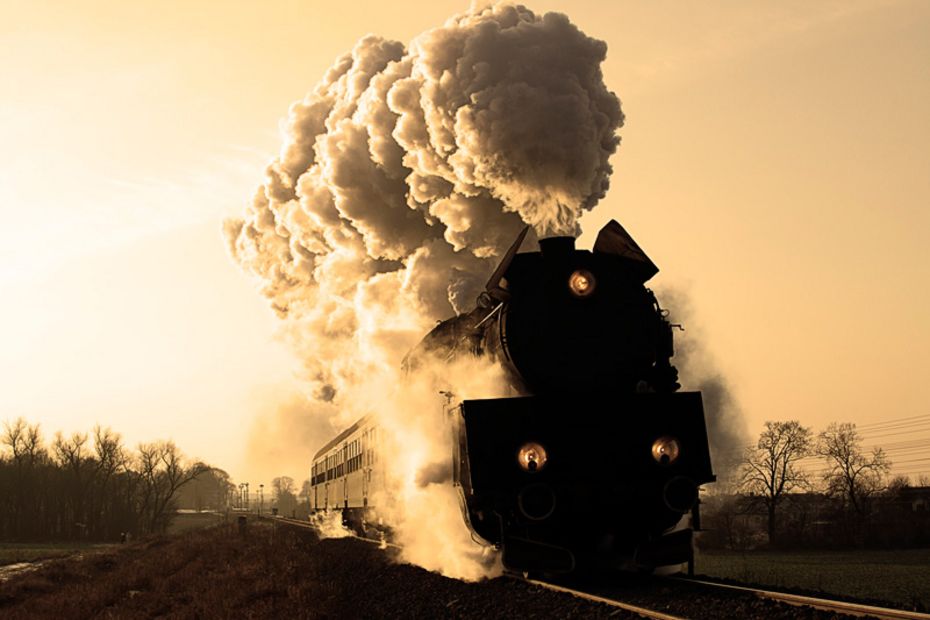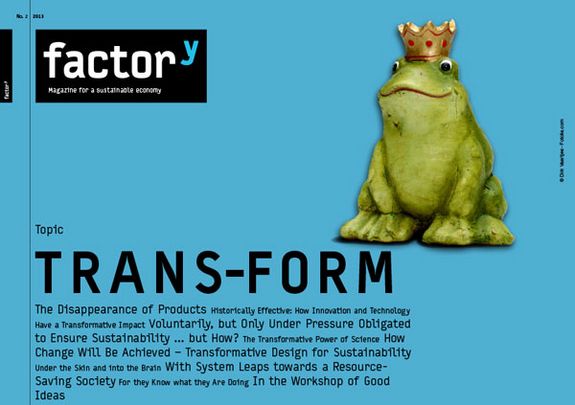Trans-form

The London underground is 150 years old. In the beginning, nobody was really in favour of this innovation in mobility that drove through the tunnels with steam and open carriages. An essay on the history of technology from creative destruction through innovation to transformation by the Internet of things.
By Bert Beyers
(Translated from the German by Eva Maria Flucke and Anna-Lena Vohl)
The year is 1863 when the Metropolitan Railway Company is starting to operate their first trains – underground in London. The world’s first underground. England was the motherland of the industrial revolution. And London was the biggest and richest city in the world. It suffocated in traffic. Thousands of carriages, hackney coaches and horse-drawn busses congested the streets. Hundreds of thousands of labourers lived in the city’s suburbs, because it was cheaper than living in the centre. Every day they had to go to the city – on foot. There was great need for a new efficient way of transportation.
But no one could imagine that trains could travel underground. Only Charles Pearson could. For years he beguiled investors, mediated between rival companies, and did PR work – which was desperately needed.
There was no experience, study or test in this field. London was one of the most densely populated cities in the world. The construction of the underground was like open heart surgery. Pearson had a lot of problems, and his biggest one was that the trains were running on steam power. Below ground level it smelled to high heaven. The tunnels were filled with smoke, and in the smoky tube stations, panic attacks of women and children were not uncommon.
Nevertheless, the first underground in the world was a success because it was cheap and for many people the only opportunity to get from one point to another. This is why there was a lot of money to earn with the Metropolitan Railway. It was only after 1890 – nearly four decades after the opening of London’s underground – that the problem with the steam engine was solved by the invention of the electric motor.
These are innovations that change people’s lives all at once. The fact that it took a lot of hard work is soon forgotten.
Innovations destroy
The railway – or more precisely the American railway industry – was also the favourite example of the economist Joseph Schumpeter, who dealt extensively with the role of innovation and the ‘creative destruction’ of the existing order. In the 1830s, the U.S. Government supported the railway companies through large land allocations. Together with the settlers, they expanded the U.S. towards the west. At the end of the 19th century, an enormous railway system covered all regions of the United States. Chicago was a child of the railway as well as Omaha, Fort Worth, Denver and many other cities. Hundreds of innovations were established, both small and large. Enormous amounts of money changed hands, and, due to the assistance of joint-stock companies, huge investments were possible. The new way of transporting goods sped up trade, and a coherent single market was created. Schumpeter considered this transformation not only as the result of technological advances but also from of historical progress – in which he was especially interested – and the changes in the markets whose parameters have to be adjusted accordingly. This reveals that technical advance is Janus-faced, because it solves problems while creating new ones at the same time. The boomerang effect was probably first described by the British economist Stanley Jevons in the mid-19th century. He said that it was a complete distortion of ideas to assume that the economical use of fuel would lead to lower consumption. It was, in fact, quite the contrary, as the general rule is that new ways of economy entail an increase of consumption – in many respects. Jevons gives the steam engine by James Watt as an example. It was approximately 17 times more energy-efficient than its predecessors, but it led to an enormous increase in coal consumption.
The boomerang effect plays a central role in the opinion of the philosopher of technology Jacques Neirynck. He demonstrates that progress normally creates an increased demand on the respective technical system and nature, because the access to more and different resources (e.g. deep-sea oil drilling) becomes possible, which usually causes the prices of goods to drop. But even when falling prices in saturated markets do not make a direct impact on demand anymore, i.e. when every household has a computer, television, car etc., even then efficiency can lead to increased consumption. Then the saved money will be invested in holidays – which is the indirect boomerang effect. At the end of the day, a tremendous and ever increasing pressure on the ecosystem of the earth remains.
Innovations socialise
The systems theorist Franz Josef Radermacher sees in this process a fundamental pattern that can be retraced throughout history. He considers the ‘superorganism of humankind’ as a system that generates, spreads and passes on knowledge. Organisation, technology and mastery of material play a central role in this. Bows and arrows as well as the modern plane are all materialised ideas. Each technical innovation results directly or indirectly in the fact that people live longer, communicate more with each other and continue to invent.
This is why nowadays we see great ideas for renewable energy sources, intelligent networks, and new concepts of mobility in cities, sustainable aquaculture, and smart materials everywhere. In addition, there is a comprehensive informatisation of life and the world of work. The Internet of Things is already in progress and consists of everyday objects, devices and goods that become addressable and can be followed through time and space. Cars, rooms, and entire areas of production are becoming ‘intelligent’. Mobile interfaces are omnipresent, and the invention of mobiles is followed by data goggles. And what happens next?
The history of technology and innovation of society and economy shows how our ancestors have repeatedly overcome limits. And despite all of the setbacks, catastrophes and wars, the number of people has continued to increase.
In the 21st century, this process is about to come to an end. The rapid increase in population over the last few centuries has already slowed down, and is expected to level out at nine or ten billion around mid-century. This will happen for various reasons: the industrialisation of the emerging countries, the scarcity of resources, and stress. Whether this will be a fairly peaceful transition is uncertain.
Literature:
Gunkel, Christoph. Bei Abfahrt Erstickungsanfall. 150 Jahre Londoner U-Bahn. Spiegel Online, 10 January 2013. (German)? (Attacks of suffocation upon departure. 150 years of the London Underground)
Grübler, Arnulf. Technology and Global Change. Cambridge: Cambridge University Press, 1998. Print.
McCraw, Thomas K.: Prophet of Innovation: Joseph Schumpeter and Creative Destruction. Harvard: Belknap Press, 2007. Print.
Neirynck, Jacques. Der göttliche Ingenieur. Die Evolution der Technik. expert verlag GmbH: RenningenMalmsheim, 1998. Print. ?(The Devine Engineer. The Evolution of Technology)
Radermacher, Franz Josef and Bert Beyers. Welt mit Zukunft. Die Ökosoziale Perspektive. Murmann Verlag GmbH: Hamburg, 2011. Print. (Our World’s Future. An Ecosocial Perspective)
Bert Beyers is a writer and journalist in Hamburg, Germany. He frequently writes articles for Factory; his latest contribution was ‘Columbus’ Egg’ in the factory issue entitled: BE(A)WARE.
More articles to the topic-range of transformation, transition and change you will not only find online than in our magazine Trans-form. The PDF-magazine contains additional facts and citations, is nicely illustrated and quite good readable on tablets and screens.
Beiträge online
TRANS-FORM

- The Disappearance of Products
- Historically effective: How innovation and technology transform
- Freiwillig nur unter Zwang. Nachhaltig verpflichtet, aber wodurch?
- Mit Systemsprüngen zu ressourcenleichten Lebensstilen
- The Transformative Power of Science
Themen
- The Domino Effect: the Mobility Transition as an Engine for the ‘Great Transformation’
- Cities Use the Space
- Decarbonization by 2030
- The fear of biting the hand that feeds you
- Where investing is a pleasure
- Why divestment is going to change the world
- A Robin Hood tax for climate protection
- May the Force Be with Us
- Modern Strategies
- The prerogative of interpreting the future now lies with the companies involved in climate protection”
- From Negotiating to Trading Equitably
- Can a donkey be tragic?
- Rethink rather than rebound: a sufficiency revolution must precede the efficiency revolution
- On Rebound, Prebound and Performance Gaps
- So Let Us Seize Power Then!
- With Common Property Against Political Failure
- So Let Us Seize Power Then!
- The Comforting Beauty of Failure
- “It Is Not Impossible at All.“
- Resource-light shopping
- Men Have Not Stopped Giving the Advantage to Women – So Far
- Toothpaste for Princesses and Soup for Pirates
- It is about equality
- A nice day
- Initiative instead of frustration
- The right ingredients
- Resilient for Life
- Not only, but also
- Appreciation – more please!
- Worth more than money
- Learning to value the value of goods
- Worth and Values
- The Transformative Power of Science
- Historically effective: How innovation and technology transform
- The Disappearance of Products
- Growing Older 101
- Columbus’ Egg
- It Works! In Theory at Least ...
- What If...?
- Analysing Separately – Thinking and Acting Together!
- Let’s Break Away from Determined Breaking Points
- More Gold in Waste than in Mines
- The art of separation
- Should you really DIY?
- The Aesthetics of Do-It-Yourself
- Standing on One’s Own Feet
- From the handaxe to desktop fabrication
- Using Shares to Survive the Crisis
- When Citizens participate
- Possess to Participate
- The Right Growth at the Right Time
- Gunter Pauli and Blue Economy
- When Sustainability Grows
- How we treat Growth
- Illusions about Growth

